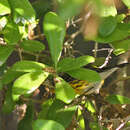en
names in breadcrumbs


A medium-sized (4 ¾ inches) wood warbler, the male Magnolia Warbler is most easily identified by its dark gray back, streaked flanks, white wing patches, and bright yellow underparts with a conspicuous black face mask. Female Magnolia Warblers are similar to males, but are slightly duller and lack the white on the wings. Both sexes resemble the male Yellow-rumped Warbler (Setophaga coronata), but that species is less streaked below and lacks the Magnolia Warbler’s extensive yellow on the breast. The Magnolia Warbler breeds across southern Canada and the northeastern United States. This species is also present at higher elevations in the Appalachian Mountains as far south as Tennessee. In winter, Yellow-throated Warblers may be found in the West Indies, southern Mexico, and Central America. Magnolia Warblers breed in a variety of dense woodland habitats, particularly those largely composed of evergreen trees. In winter, this species may be found in humid tropical forests and tropical scrub. Magnolia Warblers primarily eat small invertebrates, including insects and spiders. In appropriate habitat, Magnolia Warblers may be observed foraging for insects on the ends of branches in the middle of the tree canopy. Birdwatchers may also listen for this species’ song, a whistled “weeta weeta weetsee.” Magnolia Warblers are primarily active during the day, but, like many migratory songbirds, this species migrates at night.